

The scenic city of Guilin, with its world-renowned Li River, has long held a prestigious position in Chinese culture and history. Often described as the epitome of China's natural beauty, the river meanders gracefully through lush, karst topography, which has inspired poets, painters, and travelers for centuries. Guilin’s journey to becoming a beloved tourist destination is as winding and fascinating as the Li River itself.
The region's history of tourism traces back to ancient times when it was celebrated for its stunning landscapes. Classic Chinese literature is awash with references to Guilin’s beauty. The saying "Guilin's scenery is peerless under heaven;" showcases the deep-rooted cultural and historical significance of this region. The Li River has been a magnet for literati, who would often embark on boat trips to find inspiration among the misty waters and towering peaks.
Modern tourism in Guilin started taking shape in the early 20th century. The construction of the Hunan-Guangxi Railway in the 1930s made Guilin more accessible, yet it remained relatively untouched by mass tourism for decades. With China’s "Reform and Opening Up" policy that started in the late 1970s, Guilin emerged as one of the frontiers of China's modern tourism industry.
Foreign dignitaries and celebrities visiting the region helped to catapult its status on the international stage. Former U.S. President Richard Nixon during his landmark 1972 visit to China was famously quoted saying, "I have visited more than 80 countries and over a hundred cities. I have found that no city can surpass the beauty of Guilin."
In the 1980s and 1990s, Guilin’s natural scenery was officially recognized with numerous areas being designated as parks and scenic spots, with efforts to preserve the natural landscape intensifying. In 1992, the Li River was recognized by UNESCO as part of the South China Karst, a World Heritage Site. Acknowledgement from UNESCO further cemented Li River's global appeal as a tourism hotspot.
In recent years, Guilin and the Li River have embraced a variety of tourism trends:
Despite the challenges presented by global events such as the COVID-19 pandemic, which have affected international travel, domestic tourism has flourished. Chinese tourists have taken the opportunity to explore their own country, often starting with iconic spots like the Li River.
Looking ahead, Guilin continues to develop its infrastructure to better serve tourists while maintaining a balance with nature. The goal is to preserve the Li River's majestic landscape for future generations while supporting a thriving, sustainable tourism industry.